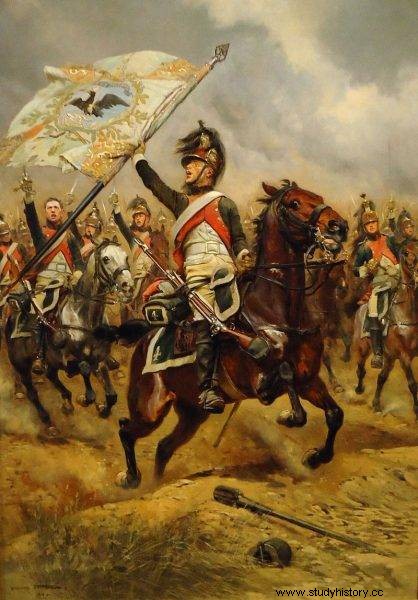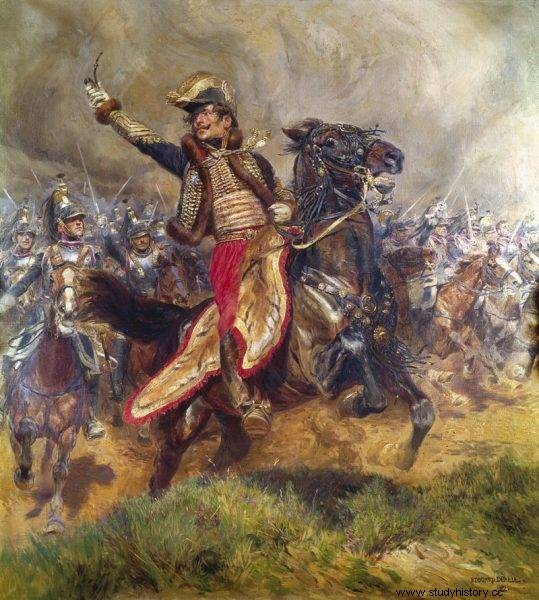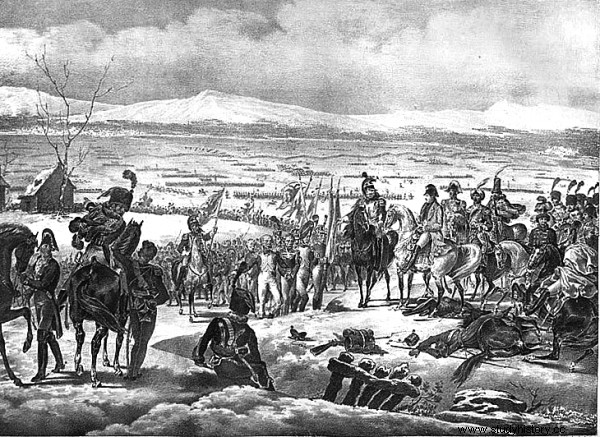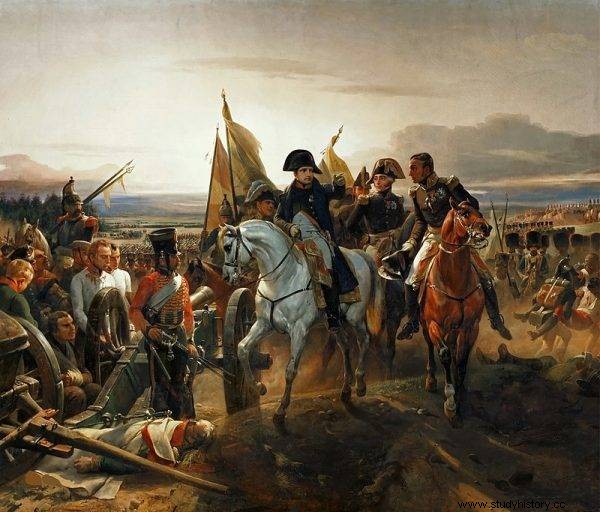"Poland is a swamp" - wrote an officer of the Grand Army. But it was the two battles fought in Mazovia (near Gołymin and Pułtusk) that marked the beginning of Napoleon's end.
"Poland is a huge swamp, scattered with meager villages and a few decaying farms, which the local nobility call their mansions" - wrote in the winter of 1806 an officer of the Great Army going to meet the Russians. This gloomy picture did not bode well for me. Napoleon's faiths were not improved even by the wine served in larger quantities at the imperial order and by the fact that they had just defeated the Prussian war machine.
Indeed, after the devastating victories of the French at Jena and Auerstedt on October 14, 1806, it could have seemed that Napoleon was on the way to subjugate almost all of Europe . Of course, Great Britain - the driving force of all anti-French coalitions - and Russia remained out of control. Against Albion, the emperor aimed what he thought was the most effective weapon in the form of the continental blockade. However, the Russians licking their wounds after Austerlitz were still a real threat.
The war continues
In St. Petersburg, the alarming news of the fall of Prussia was closely followed, the more so because for a long time the soldiers of King Frederick William III could only escape . Prussian troops and fortresses surrendered without a fight. Sometimes only at the mere sight of advancing French cavalry.

after the devastating victories of the French at Jena and Auerstedt on October 14, 1806, it could have seemed that Napoleon was on the way to subjugate almost all of Europe.
Interestingly, despite the evident defeat, the ruler of Prussia did not intend to officially capitulate or negotiate with Napoleon. On the other hand, he willingly gave the remnants of his army under Russian command. This decision pleasantly surprised Tsar Alexander I. He decided to fulfill his allied commitment and support the Prussian king with his army. As historians emphasize, this decision required a lot of courage. Especially since some advisers recommended the tsar to make peace with Napoleon or at least avoiding armed confrontation. The vision of the defeat at Austerlitz was still alive.
As a result, Napoleon, counting on the end of the war, had to come to terms with the fact that the broken Prussia was not only still fighting, but also in this fight they were not alone.
What a climate and what a terrible country!
With these words, Marshal Joachim Murat was to comment on the march of the 100,000-strong Grand Army through the Polish lands. The hitherto hardships of the pursuit of the Prussians turned out to be a nice escapade in the face of the ordeal that Napoleon's sisters had to endure in "the wilderness and endlessness of a wild country melting into mud and poverty" - as they recalled years later.
It was the real end of the world for them. Streams of water pouring down from the sky from the beginning of November only added to the horror of the situation. And so the hopeless condition of the roads, additionally blurred by downpours, made it difficult not only to move forward, but also to obtain food and forage . The supply lines stretched as far as Berlin and further to France made it impossible to provide fast food supplies. Organizing bread on the spot for a single unit, even for a day, was almost a miracle.
Despite these difficulties, the Great Army, languishing in sight, but full of its victories so far, reached Warsaw at the end of November, from which the Russians had just withdrawn. This is also where the drenched and angry emperor arrived on December 19. His gloomy mood was caused not only by the sluggish campaign of his commanders, but also by the necessity to travel part of the way by a peasant cart. The Imperial carriage simply did not cope with the Polish mud.
Your eye
The arrival of Napoleon significantly accelerated the actions of the Grand Army. Under his watchful eye, the military warehouses stripped by the Russians began to fill up. Experiencing the tsarist tactics of the scorched earth so far, the Napoleonic soldiers could finally eat their food and rest a bit.

The arrival of Napoleon definitely sped up the activities of the Grand Army.
It was even said that in view of the problems with running the campaign so far, Napoleon intended to fall into the winter lair, in order to move decisively against the Russians in the spring and finally force them to fight openly . But it was precisely this passivity of the tsarist troops that turned out to be an irresistible temptation for Napoleon. Especially since the weather seemed to work in favor of the emperor. It got colder. The frozen, muddy tracks were finally fit for a relatively smooth march. The emperor therefore commissioned his marshals to vigorously pursue the enemy.
Chaos
Napoleon saw that although the Russians had a large army, their main problem was the question of command. The 69-year-old field marshal Mikhail Kamiensky, nominated by the tsar as commander-in-chief, was completely unfit for this, if only because of his age and poor eyesight . He himself was well aware of his handicaps. He repeatedly asked Alexander to be dismissed from such an honorable position. The Tsar, however, had no choice. He blamed Mikhail Kutuzov for the defeat at Austerlitz, and he simply did not like Piotr Bagration. He forced the almost blind marshal to accept the nomination.
The problem with the commander-in-chief could perhaps still be survived, if everything went well on the lower levels. Meanwhile Generals Levin von Bennigsen and Friedrich von Buxhöwden sincerely hated each other and with energy worthy of a better cause, they plotted against each other . In this situation, due to the very sparing orders of the field marshal, their actions were not coordinated. However, it had its advantages. The chaos in the ranks of the Russians puzzled the French who followed them.
Division of forces
The chase for the Russians and Prussians, launched on December 21 with great enthusiasm, seemed to have a great chance of success. For the next three days the French managed to cross Wkra. In a series of skirmishes, they divided part of the tsarist army into two groups . The larger of them, under the command of Bennigsen, moved towards Pułtusk. Conducted by Fr. Dmitry Golitsyn, a smaller group headed for Golymin.

Conducted by Fr. Dmitry Golitsyn, a smaller group headed for Golymin.
There was only one "but" in this undoubted success - Napoleon actually knew nothing about it . And this ignorance was contributed to by ... the weather, which again began to play an increasingly important role. The previous frosts gave way to rapid warming. As if that were not enough, heavy rains soon came. One of the Napoleonic soldiers recalled:
"The fields, the roads and the plains themselves have become a real swamp. Cannons and carts disappeared in this terrible land, and at every step you could see horses, buried in the mud for rumps, which, in order to breathe, had to keep their necks stretched up " .
In this situation, the efficient work of the intelligence was also difficult. As a result, the emperor did not know the exact position or numbers of the enemy. Nevertheless, he decided, contrary to his fundamental principle of not dividing his own forces before the battle, on the preventive deployment of Marshal Lannes' corps (25–27 thousand soldiers) towards Pułtusk, and marshals Murat, Augereau and Davout (38 thousand) to Gołymin. Alone with most of the troops he went further north - to Ciechanów. It was there that he expected to meet the main Russian forces.
Błotny Golymin
December 26 proved him wrong. The first sobering up occurred near Gołymin. In the morning, the forces of Fr. Golitsyn. The Russian commander, after merging with the troops of General Dochturow, intended to give his soldiers a rest, and then move further east. His plans, however, were shattered by the arrival of around 10 forces of French marshals who almost in advance launched a cavalry attack on Russian positions.
Golitsyn was not surprised, however, and, under the cover of his own cuirassiers, prepared to accept the battle. So when at 14 French infantry troops arrived on the battlefield, they were greeted by a hurricane fire of rifles and well-fired guns. The latter, unfortunately, did not have the Napoleonic marshals. All they had at their disposal at the beginning of the campaign drowned in the mud or simply did not keep up with the driving and walking.
The successive waves of infantry thrown by the marshals to attack were of no avail. Surrounded by forests and marshes Golitsyn, having only 18 thousand. soldiers and 30 guns, he successfully resisted an opponent that was twice as strong. Also, attempts to circumvent the Russian positions usually ended in failure due to the soggy terrain. The ubiquitous mud (a true symbol of this campaign) meant that the maneuvers of the French were performed at a snail's pace. This gave the Russians time to regroup appropriately.
Hell's Brigade
The repeated charges of the Napoleonic cavalry were also losing their momentum and effectiveness on the shaky ground. As if that were not enough, during one of them the so far fearless hussars of General Lasalle's hellish brigade, attacking the Russian cannons, suddenly stopped. Why? Apparently one of the officers gave such an order. Confused and surprised by this, the frontline soldiers punished their mounts right in front of the positions of the equally surprised tsarist gunners. The latter did not last long, however. As soon as the still unknowing squadrons of the next line crashed into the standing hussars, the Russian cannons opened fire on the swirling mass of men and horses.

The so far fearless hussars of General Lasalle's infernal brigade, attacking the Russian cannons, suddenly stopped.
The massacred ranks escaped in front of General Lasalle, devastated by this sight. At one point he was alone with the tsarist artillery. Miraculously escaping death, he efficiently regrouped the bloodied squadrons that had survived and turned back towards the Russian cannon outposts. But even this time his riders were not able to catch them, because ... Lasalle stopped the entire formation right after they came into the range of enemy cannons. It was supposed to be a punishment for breaking the charge. Despite the falling bullets and bloody gaps in the ranks, the hussars humbly persevered in this motionlessness until dusk. It was only when the infantry and other cavalry units entered Gołymin that the brigade moved forward, but not for a stop. One more penance fell on the disgraced fleeing in the face of the enemy - providing a peaceful rest to the weary victors.
50 thousand Murat
For despite temporary successes and brave fending off French attacks, Fr. Golitsyn was well aware that time was not his ally. The pressure of the marshals did not diminish. It was not known what other forces they still had, as they allowed the shooting of the stationary Lasalle squadrons with impunity.
Meanwhile, a thousand soldiers and 10 guns were reduced from the ranks of the prince, and there was no need to count on reinforcements. Therefore, taking advantage of the falling darkness and skilfully using the possessed forces, Golitsyn broke away from the enemy. Undeterred, he continued on to the east. Soon after the departure of the Russians, the marshals appeared in the city, but they did not decide to pursue the enemy at night. They also did not know what other forces Golitsyn had at its disposal. Moreover, the scale of the Russian resistance was so great that Murat was even supposed to report to the emperor about the battle with the 50,000 (!) Army of the tsar.
Pułtusk puddle
Murat's vision perfectly matched the forces that Marshal Jean Lannes faced on the same day at Pułtusk located 19 km south-east of Gołymin. It was there that General Bennigsen, furious for omitting from the appointment of commander-in-chief by the finally retiring Field Marshal Kamieński, decided to resist - against the order of further withdrawal. soldiers and 120 guns, he waited only for French troops breaking through the sea of mud . He did not know how much force he would face, but the defensive position of his position on the hill gave him hope for success.

The unresolved battles at Gołymin and Pułtusk unquestionably meant that Napoleon's star began to fade.
Around The first 10 regiments of French infantry appeared on the edge of the forest surrounding the city to the west. The Napoleonic marshal also had no idea about the size of the enemy's forces. However, without hesitating a moment, he ordered the attack. His soldiers drove off the Cossack cavalry. Then, after a short fire exchange, they even clashed with the tsarist village leaders. The Russians gave way and soon counterattacked.
Of course, repeatedly repeated cavalry charges and infantry attacks slowed down the mud, but it did not diminish the fierce fighting in any way. However, when it seemed that the enemy and the marshy ground would be the fighters' only problems, a blizzard came over the battlefield, which additionally blinded both sides . The soldiers began to attack by heart, often accidentally crossing bayonets with their own troops. The visibility, limited in places to a few meters, made the advancing columns covered with snow appear to the enemy at the last moment. Also, the artillerymen from both sides had to stop firing from time to time because they did not know at all who they were shooting at.
The beginning of Napoleon's end
The raging nature even forced the fighting to stop at some point. But when the blizzard subsided a bit and both sides caught their breath, the fear flared up again. The stiffness of the Russian resistance went into competition with the relentless attacking French. The latter performed miracles of bravery, maneuvering in the foreground of the city turned into a muddy puddle. Some of the positions changed hands many times, but neither side was able to tip the tide in their favor.

"The era of partial successes and incomplete triumphs has come," wrote one of the soldiers of the Grand Army.
Eventually at approx. The 20th battle was over and both sides fell on the lines ... occupied in the morning. At the same time, both Bennigsen and Lannes felt themselves masters of the battlefield. And this is how they communicated it to their highest superiors, while appropriately coloring their triumph. However, while the marshal limited himself to exaggerating the Russian losses (over 5,000 killed and wounded) and grossly lowering his own (600-700 people), Bennigsen reported to the tsar the defeat of the 60,000 army led by Napoleon himself who at that time was looking for an opponent somewhere near Ciechanów.
And although the emperor of the French probably did not want to acknowledge this, the pending battles at Gołymin and Pułtusk undoubtedly meant that his star began to fade. "The era of partial successes and incomplete triumphs has come," wrote one of the soldiers of the Grand Army.
